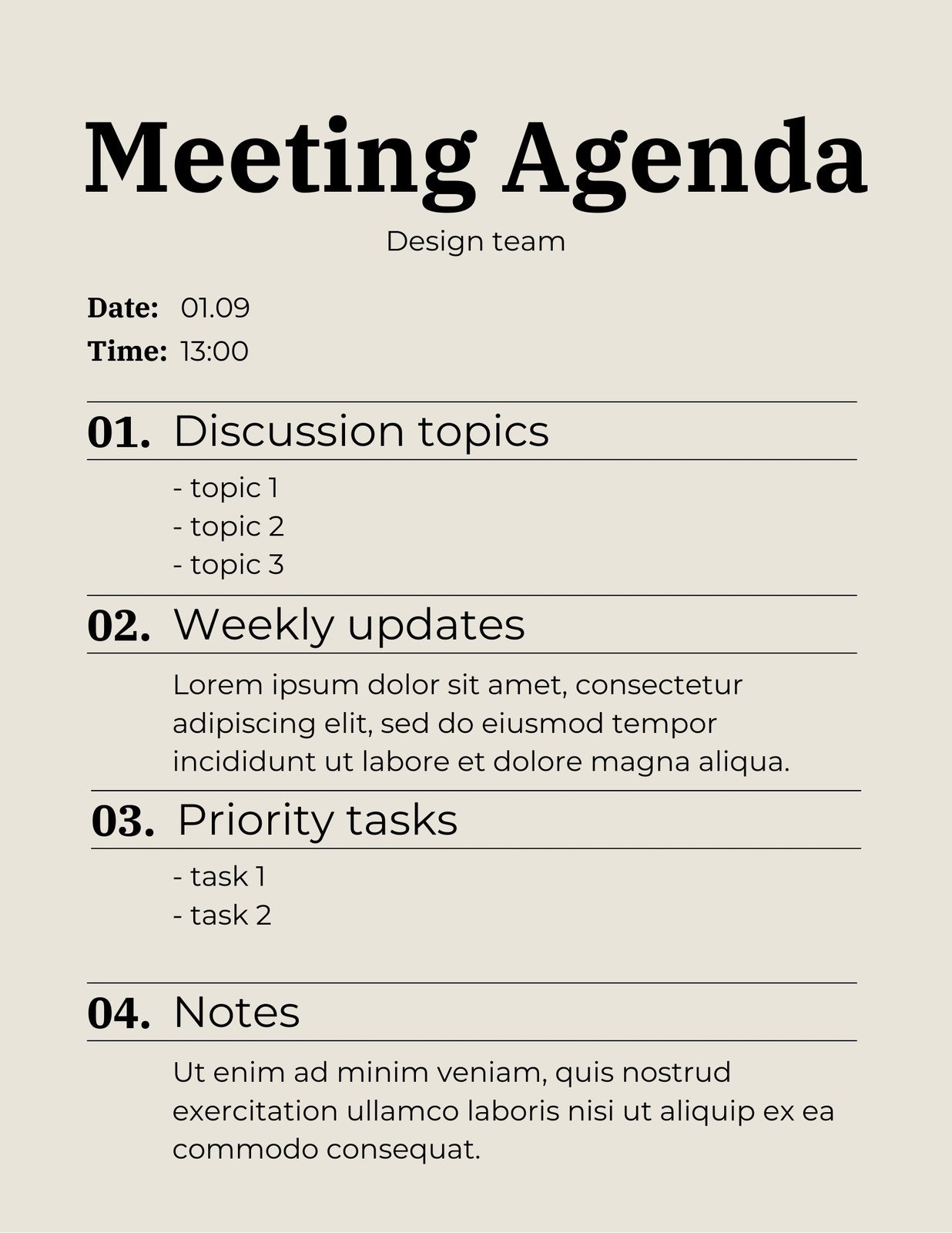Introduction
Meetings. We all have them. Some are productive powerhouses, while others feel like a complete waste of time. The key to a successful meeting lies in proper planning, and a crucial element of that planning is the agenda. A well-crafted agenda sets the tone, keeps the discussion focused, and ensures everyone is on the same page.
What is a Meeting Agenda?
In simple terms, a meeting agenda is a roadmap for your meeting. It’s a list of topics that will be discussed, along with a brief description or action items for each. Think of it as a to-do list for your meeting – it outlines what needs to be accomplished.
Why is a Meeting Agenda Important?

Image Source: canva.com
Keeps the Meeting on Track: A clear agenda prevents the meeting from veering off course into irrelevant discussions.
Creating a Meeting Agenda: A Step-by-Step Guide
1. Determine the Meeting’s Purpose: What is the main goal of this meeting? Is it to brainstorm new ideas, solve a specific problem, make a decision, or provide updates?
2. Identify Key Topics: Brainstorm the main topics that need to be discussed to achieve the meeting’s purpose.
3. Prioritize Topics: Order the topics based on their importance and urgency.
4. Assign Time Slots: Allocate specific timeframes for each topic to ensure that all items are covered.
5. Include Action Items: For each topic, identify any action items that need to be completed before or after the meeting.
6. Assign Responsibilities: Clearly assign who is responsible for each topic and action item.
7. Distribute the Agenda: Share the agenda with all attendees in advance of the meeting, ideally a day or two beforehand.
Sample Meeting Agenda
Meeting Title: Marketing Team Meeting
Date: [Date]
Time: [Time]
Location: [Location]
Attendees: [List of Attendees]
1. Welcome and Introductions (5 minutes)
2. Review of Last Meeting’s Action Items (10 minutes)
Discuss the progress made on action items from the previous meeting.
3. Q3 Marketing Campaign Performance (20 minutes)
Review key performance indicators (KPIs) for the Q3 marketing campaign.
4. Social Media Strategy Update (15 minutes)
Discuss the latest social media trends and best practices.
5. Website Redesign Project (20 minutes)
Discuss progress on the website redesign project.
6. Open Discussion and Q&A (15 minutes)
7. Action Items and Next Steps (5 minutes)
Review and assign action items for each topic discussed.
8. Adjournment (2 minutes)
Tips for Effective Meetings
Start and end meetings on time: Respect everyone’s time.
Conclusion
By following these tips and using a well-structured agenda, you can transform your meetings from unproductive time-wasters into valuable and efficient opportunities for collaboration and progress.
FAQs
What if the meeting agenda needs to be changed?
If the agenda needs to be changed, it’s important to communicate the changes to all attendees as soon as possible. You can do this by sending an updated agenda or by briefly outlining the changes at the beginning of the meeting.
How can I ensure that everyone stays engaged during the meeting?
To keep everyone engaged, encourage active participation by asking questions, soliciting feedback, and using interactive exercises. You can also use visual aids, such as presentations or whiteboards, to make the meeting more dynamic.
What should I do if a meeting goes off track?
If the meeting starts to deviate from the agenda, gently but firmly guide the conversation back on track. Remind the group of the meeting’s objectives and the time constraints.
How can I make meetings more inclusive?
To make meetings more inclusive, create a safe and respectful environment where all voices are heard and valued. Encourage diverse perspectives and ensure that everyone has an equal opportunity to participate.
How can I measure the effectiveness of my meetings?
After each meeting, take some time to reflect on its effectiveness. Did the meeting achieve its objectives? Were the discussions productive? What could be improved for future meetings?
I hope this article provides you with a helpful framework for creating effective meeting agendas and conducting successful meetings.
Meeting And Agenda Sample